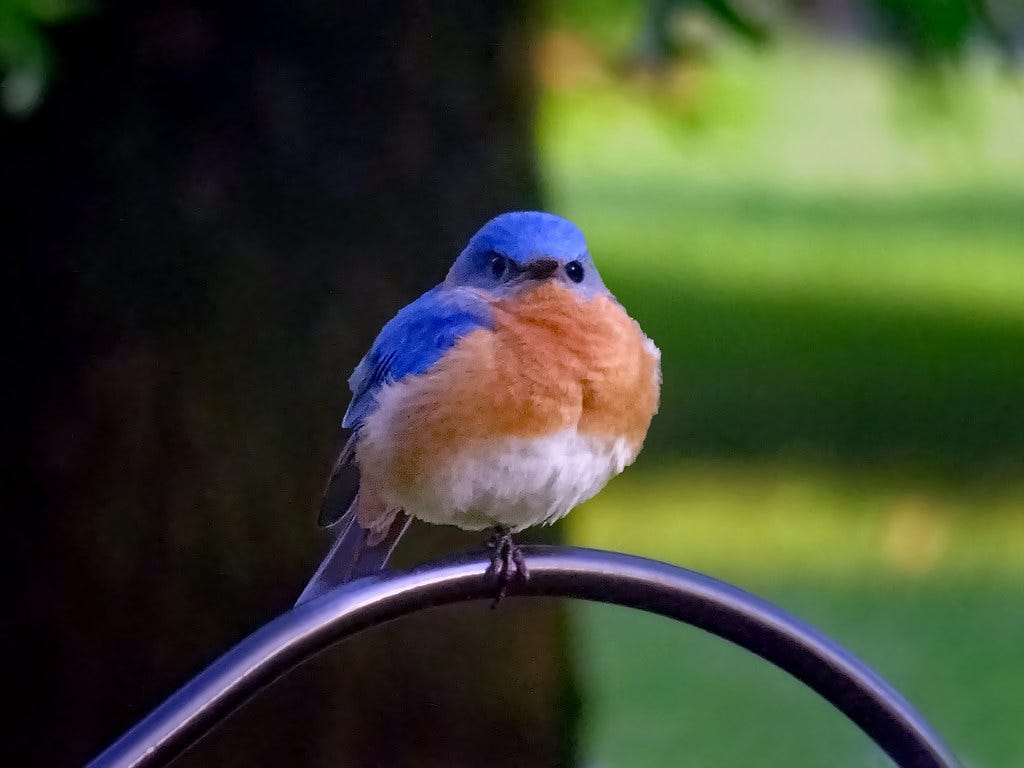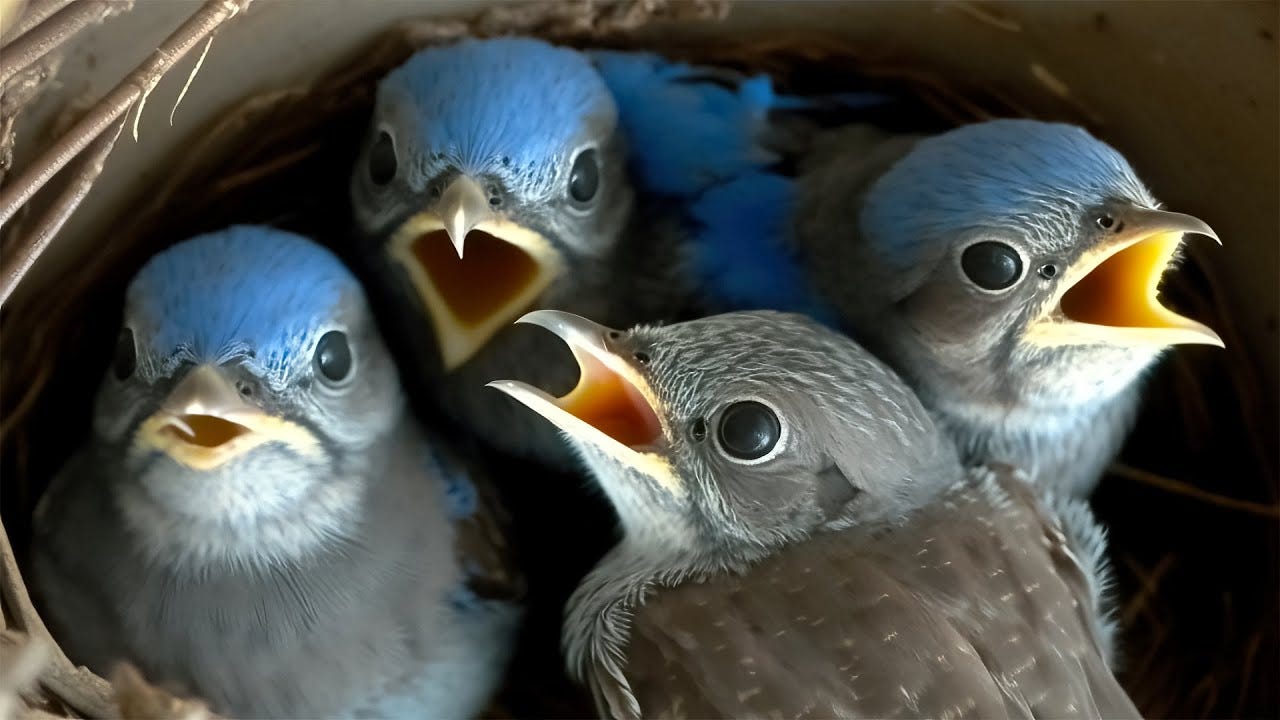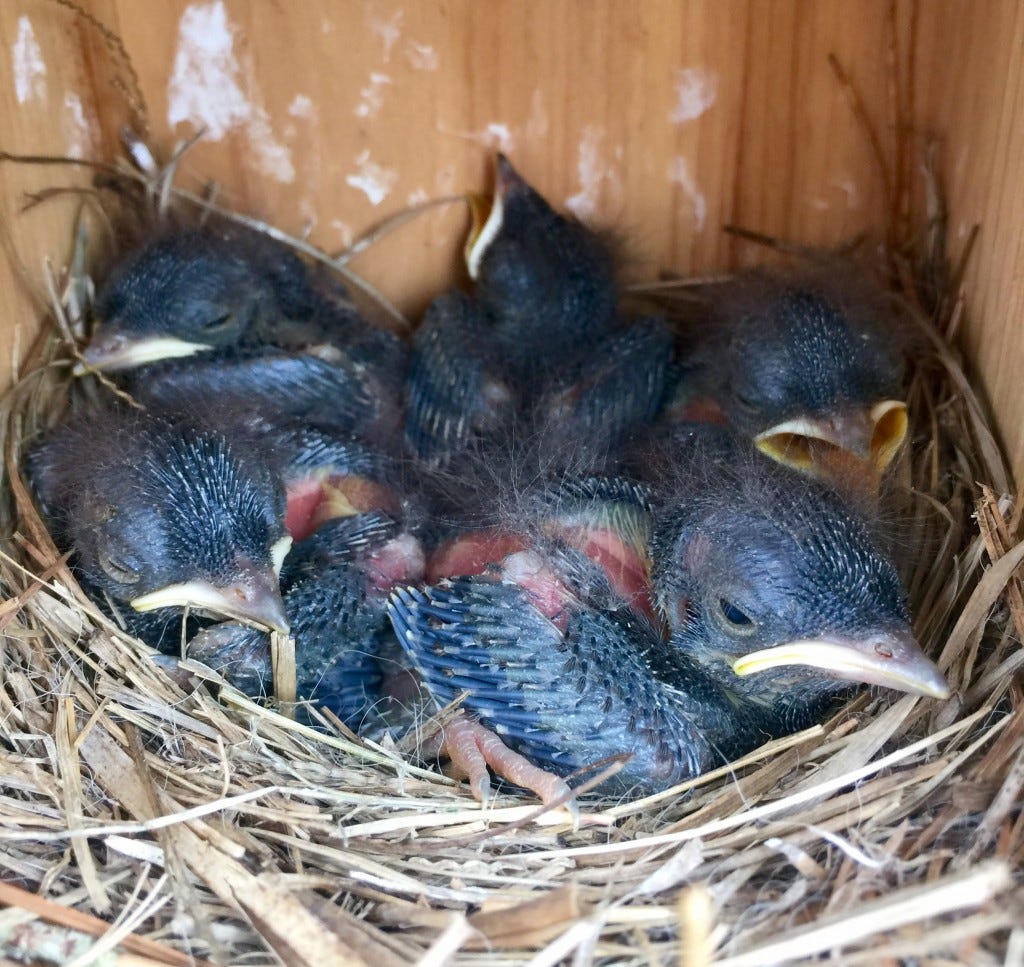The following day, the situation with the Flashbirds follows a predictable scenario. The second fertilized Flashbird lays her eggs in the communal nest—Na-Yeli counted fifty-one in the slow-motion replay—and the two mothers take turns brooding. And while the mothers do eat, the single non-fertilized Flashbird keeps overeating. The latter lasts until a male Flashbird shows up sometime after noon and faultlessly performs another courting dance & song. His success rate today is 100% as the last unfertilized female relents, and the inevitable wild mating follows suit.
The day after that, the last fertilized Flashbird adds her eggs to the communal nest—exactly fifty according to Na-Yeli’s count—and the three, now again normal-sized, birds take turns through night and day, brooding, guarding, and foraging.
As Na-Yeli wonders about the usefulness of the guarding, a Foxy the Cat tries its luck by attempting to rob the nest. It has realized that it can’t catch these super-fast birds, so it figures their eggs should be a much easier target. It doesn’t bother to hide itself, it just walks up to the nest, fully intending to chase away the two Flashbirds—one asleep while brooding, one guarding, while one is out foraging—as it goes for its morning omelet.
Well before Foxy the Cat gets close to the nest, the guarding Flashbird takes off flies almost straight up and lets out a shrieking, heart-rendering call that must carry quite far. Then she dives down, with tremendous speed, and spears herself, sharp beak forward, straight into Foxy the Cat’s back. The predator’s growl is an equal mix of surprise, alarm, and agony. One of its forepaws reaches for the bird missile on its back, but the Flashbird’s gone already, up in the sky, bellowing another battle-cry-cum-warning-siren. Shortly after the guarding Flashbird strikes the flummoxed fox-tailed feline a second time, the third Flashbird arrives at the scene with blinding speed, attacking the catlike predator in a similar manner.
The poor Foxy the Cat’s calls become ever more shrill, pure yelps of agony as the two Flashbirds keep attacking relentlessly. It doesn’t take long for Foxy the Cat to decide it’s had more than enough as it retreats, sprinting hard while crying in sheer anguish. The blood welling up from the Flashbirds’ cuts is sufficient to tell the story of an unsuccessful raid.
Never anger a mother, Na-Yeli thinks, and most definitely never anger three brooding Flashbird mothers.

The day after the window for nest robbing has expired as the first eggs are hatching. After three days already? Na-Yeli thinks, These Flashbirds certainly don’t dawdle on anything. As the first brood hatches, the duties of the three mothers remain the same: one brood mother who stays on top of the remaining eggs, one guardian angel who also prevents the freshly-hatched, inquisitive chicks from straying too far from the nest, and a foraging provider who’s now working overtime to keep an increasing amount of mouths fed.
The chicks are just the cutest—their soft, fine fluffy feathers a heartbreaking mauve, although she does spot the very odd aquamarine one, is this a boy? They crawl over each other, along each other, on top of each other, then tumble down so charmingly it makes Na-Yeli giggle. They flap their tiny, rudimentary wings with no chance of leaving the ground. They give little, playful headbutts to their mammas, not caring which of the three their actual mother is. Even as they trip over their own tiny feet, they do it in the most endearing ways possible. When they hear the sound of one of their foraging mother’s quick-flapping wings, they open their tiny beaks, neatly synchronized, to impossibly large feeding mouths. Their wee black eyes are bottomless pools of love, need, and adoration. And then there’s a hundred more to come, Na-Yeli thinks, not sure if she can take such an overdose of innocent delight, truly an epitome of cuteness.
Unfortunately, Na-Yeli must refrain from trying to stroke one, as she suspects that the Flashbird Mothers’ violent attacks might even pierce the metamaterials of her exoskin. And, of course, she must remain a neutral observer. But the itch to caress these endearing chicks is well-nigh irresistible. So cute!
Yet, at night, she turns her attention to the polar opposite of cuteness—the Wall of Tentacles. Too many questions remain, and they can’t be solved by observations from a large distance. Once she is a bit more mobile—damn, this complicated fracture heals slowly—she intends to go to the bottom of the world-encompassing ridge. Literally, as the top is still too dangerous. It cannot be a tectonic phenomenon, so if it’s not artificial—she tries to imagine the old megafauna building it but fails—then how did it come to be?
And the golden tentacles themselves—gilded nightmares from truly Cthulhuesque depths—must be explored, as well. Obviously, she won’t ask her alien friend to do that—even if it seems to have no trouble avoiding the terrible whip cracks—but will try to send a few Kittis up there first. Kittis so small that the tentacles—however they do that—don’t detect them. Figuring out how these oversized flaxen tendrils sense an aviator approaching is very high on Na-Yeli’s list of mysteries to be solved. Inevitably, at some point—once she’s fully recovered—she must cross that barrier herself.
OK, she could try drilling through the ridge or even tunnel under it, but that would be her last resort, as it feels like cheating. She should overcome these Mountains of Madness by understanding them, not by bypassing them.
Another morning, another hatching. Fifty-one more balls of sheer cuteness unfurl into a mauve mini-mountain of crawling, bobbing, slipping, and sliding fur balls. Only two aquamarine exceptions, just like the previous brood. Only about two in fifty is a male, Na-Yeli thinks, That’s a female-to-male ratio of twenty-five to one. Which is extremely strange, as the sex ratio between female-male reproduction is typically 1:1. Something is stacking that deck in favor of an overabundance of women, but how? And why?
It should now be getting next to impossible for just one Mother to keep those one hundred inquisitive young chicks from straying too far from the nest. Still, they all stay within a safe perimeter from the brooding and the guarding mothers. Wondering about it, Na-Yeli notices that some of the older chicks—the ones from the first hatching—sometimes push their younger—well, not sisters—nestlings back when they move too far from the burrow.
The foraging mother who tries to feed one hundred mouths throughout her shift is the one who really has trouble keeping up. She flies on and off with food as fast as she can, and it’s no wonder that when her shift is done, and she becomes the brooding mother, that she falls asleep almost immediately, totally exhausted. Yet it’s the light sleep of a mother, awake at the slightest sign of danger.
Danger there will be, as Na-Yeli’s infrared sensors see a Jeffrey VanderBlues hiding high up in a tree nearby. It must be itching to try its luck, as one hundred delicious, ineluctable snacks are wobbling around under its eyes. But it refrains, maybe because it has witnessed how Foxy the Cat was attacked? Na-Yeli wonders how long it can hold out.
The next morning, like clockwork, the final brood comes out of their shells, fifty more fluff-balls joining the huge family as the roles of the three mothers change. In the daytime, only one stays with the nest, guarding the offspring and keeping the fuzzy hordes near the nest, assisted by the oldest fledglings. The other two mothers become foragers and fly on and off, tirelessly feeding the one-hundred-forty-four mauve girls and the six aquamarine boys.
Later that same day, the Jeffrey VanderBlues takes its chance, as now only one mother bird is guarding one-hundred-and-fifty chicks. It should be able to get away with at least one little snack. It jumps down from the nearest tree and sprints towards the Flashbirds’ nest.
The guarding Flashbird notices it immediately and counter-attacks with a vengeance. It gets airborne in no time, heads for the predator’s head, and fiercely strikes it on the skull with its sharp beak. This irritates the hungry predator, but not for long, as it resumes its sprint towards the one-hundred-and-fifty snack buffet. The guarding mother flies straight up, lets out a short and intensely loud call for help, and then immediately goes for the predator, again, this time striking it close to one of its eyes. This really gives the predator pause as it lashes out with one of its forepaws at the wild attacker. But that attacker is already long gone, the next shriek for help even louder as it turns around for the subsequent retaliation.
Despite the guarding bird’s fierce defense, the Jeffrey VanderBlues is now almost within striking range of the mauve chicklet masses. These finally see that they’re in grave danger and scatter. In its panic, one of these inexperienced baby birds hobbles right toward the oncoming predator. The fate of this unfortunate fledgling seems sealed as—with an astonishing speed—the cavalry arrives.
The two onrushing, foraging mothers strike Jeffrey VanderBlues in its side simultaneously, with such force that it tumbles off its feet. It gets up as fast as it can, but before it can even think of catching the lone chicklet, it is attacked by all three mother birds at once, who are burning with the holy fire of intense mother love, protective primal instincts, and territorial imperatives. The three fierce Flashbirds wreak havoc with their sharp beaks, and the predator retreats, crying with pain.
Once the Jeffrey VanderBlues is gone, howling its perceived injustice at the world, the motherbirds gather the young chicklets together around the nest and wait until they’ve calmed down, after which the designated foraging mothers fly out, once again, as the appointed guardian mother keeps her eyes on the offspring.
There are several more predator attacks in the next couple of days, of which only two successfully get away with one fledgling each. Still, one hundred and forty-eight left of the original one hundred and fifty, Na-Yeli thinks, Excellent survival numbers. By that time, the fledgling’s fluff has transformed into beautiful feathers: the little bellies entirely white or yellow, yet without stripes; the wings still more purple than blue, and the heads a charming carroty red. Now the first brood is learning to fly—the second and third ones will not be far behind—and as they get more agile, they become ever harder to catch for predators, as they’re becoming—like their parents—lightning-fast. It saddens Na-Yeli to think just why they will need that lightning speed.
The next generation not only learns to fly as their mothers—the three mothers don’t seem to have a preference for their own genetic offspring, they treat all fledglings the same—teach them how to forage. Na-Yeli watches with surprise as she notices how a young chicklet gets a quick, correcting stab from one of its mothers as it inadvertently tries to pick up a wrong—inedible or poisonous, who knows—seed. She even needs to watch a few sequences in slow motion as another mother teaches her—not necessarily genetic—offspring how to catch an insect in the air in full flight. My dog, they’re fast, Na-Yeli thinks, and nimble. And they grow up quickly, as well.
Author’s note: going through a rough stretch. Four more weeks and then things should calm down. Worldcon in Glasgow early August, and then some breathing space. Welcome to the new subscribers and followers! Enjoy the northern hemisphere’s summer, hope it’s not a heatwave. Take care!










